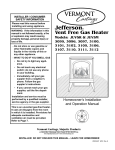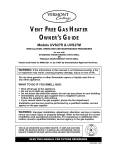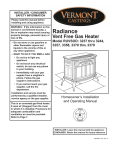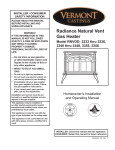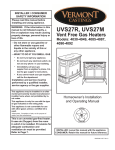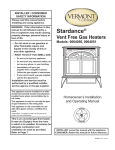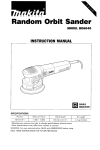Download Vermont Castings Vent Free Gas Heater JUVSR 3096, JUVSM 3096 Specifications
Transcript
Vermont Castings Jefferson Vent Free Gas Heater INSTALLER / CONSUMER SAFETY INFORMATION PLEASE READ THIS MANUAL BEFORE INSTALLING AND USING APPLIANCE. Jefferson WARNING! IF THE INFORMATION IN THIS MANUAL IS NOT FOLLOWED EXACTLY, A FIRE OR EXPLOSION MAY RESULT CAUSING PROPERTY DAMAGE, PERSONAL INJURY OR LOSS OF LIFE. Models: JUVSR & JUVSM 3095, 3096, 3097, 3100, 3101, 3102, 3105, 3106, 3107, 3110, 3111, 3112 ® Vent Free Gas Heater FOR YOUR SAFETY Improper installation, adjustment, alteration, service or maintenance can cause injury or property damage. Refer to this manual for correct installation and operational procedures. Installation and service must be performed by a qualified installer, service agency or the gas suppler. WHAT TO DO IF YOU SMELL GAS: • Do not try to light any appliance. • Do not touch any electric switch; do not use any phone in your building. • Immediately call your gas supplier form your neighbor’s phone. Follow the gas supplier’s instructions. • If you cannot reach your gas supplier, call the fire department. DO NOT STORE OR USE GASOLINE OR OTHER FLAMMABLE VAPORS AND LIQUIDS IN THE VICINITY OF THIS OR ANY OTHER APPLIANCE. This is an unvented gas-fired heater. It uses air (Oxygen) from the room in which it is installed. Provisions for adequate combustion and ventilation air must be provided. Homeowner’s Installation and Operation Manual Tested and listed to ANSI Z21.11.2.2000 INSTALLER: DO NOT DISCARD THIS MANUAL LEAVE FOR HOMEOWNER 20003447b / 0701 1m Vermont Castings Jefferson Vent Free Gas Heater ATTENTION CONSUMER: IN ORDER TO ENSURE SAFE AND EFFECTIVE INSTALLATION, THIS UNIT MUST BE INSTALLED ONLY BY A QUALIFIED AGENCY, INDIVIDUAL, FIRM, CORPORATION OR COMPANY THAT IS EXPERIENCED IN THE INSTALLATION, REPAIR AND SERVICING OF THIS TYPE OF APPLIANCE AND IS FAMILIAR WITH THE BUILDING CODES AND INSTALLATION TECHNIQUES APPROPRIATE IN YOUR AREA. CONTACT YOUR HEARTH PRODUCTS DEALER OR LOCAL GAS SUPPLIER FOR THE NAME OF A QUALIFIED SERVICE PERSON. INSTALLER: PLEASE READ THIS MANUAL CAREFULLY BEFORE YOU BEGIN THE INSTALLATION PROCEDURES. FAILURE TO FOLLOW INSTRUCTIONS MAY RESULT IN PROPERTY DAMAGE, BODILY INJURY OR LOSS OF LIFE. THIS MANUAL CONTAINS IMPORTANT USER INFORMATION. KEEP THIS MANUAL WITH THE HEATER AFTER INSTALLATION IS COMPLETE. Table of Contents Heater Dimensions ............................... 3 Safety Information ................................ 4 General Information ............................. 5 Installation Requirements ..................... 6 • Clearance Requirements .............. 8 Assembly Procedures .......................... 9 Operation ........................................... 12 Maintenance ....................................... 15 Troubleshooting.................................. 16 Replacement Parts ............................. 19 Warranty ............................................. 21 22 Vermont Castings Jefferson Vent Free Gas Heater JUVS Specifications Jefferson Vent Free Gas Heater Models JUVSRN, JUVSRP, JUVSMN, JUVSMP Fuel Manifold Pressure Min./Max. NG LP 1.7”/3.5” 5.4”/11.0” (RP) 4.4”/10.0” (MP) 11.0”w.c. 14.0”w.c. Min. Inlet Supply Pressure for adjustment: 5.5”w.c. Max. Inlet Supply Pressure for adjustment: 14.0”w.c. Min. Output, BTU/hr: JUVSR 20,000 JUVSM 18.500 Max. Output, BTU/hr: 28,000 Ignition: Piezo Firebox Weight/shipping: 110 lbs. Accessories #2960 FK28 Fan Kit IMT Optional Wall Thermostat MRC1 ZC1100 Remote Control (ON/OFF w/batteries) MRC2 ZC1200 Remote Control (ON/OFF thermostat w/batteries) MRC3 ZC1300 Remote Control (LCD ON/OFF thermostat, timer w/batteries) 21,000 18.500 28,000 This appliance may be installed in an aftermarket* manufactured (mobile) home, where not prohibited by state or local codes. This appliance is only for use with the type of gas indicated on the Rating Plate. This appliance is not convertible for use with other gases. *Aftermarket: Completion of sale, not for purpose of resale, from the manufacturer. 28¹⁄₂" (724mm) Valve Inlet C L 3" (76mm) 24" (610mm) 14¹⁄₂" (368mm) 8" (203mm) 3447 Fig. 1 Jefferson Vent Free dimensions. 3m Vermont Castings Jefferson Vent Free Gas Heater Safety Information WARNINGS IMPORTANT: READ THIS OWNER’S MANUAL CAREFULLY AND COMPLETELY BEFORE TRYING TO ASSEMBLE, OPERATE OR SERVICE THIS HEATER. IMPROPER USE OF THIS HEATER CAN CAUSE SERIOUS INJURY OR DEATH FROM BURNS, FIRE, EXPLOSION, ELECTRICAL SHOCK AND CARBON MONOXIDE POISONING. DANGER CARBON MONOXIDE POISONING MAY LEAD TO DEATH! Carbon Monoxide Poisoning: Early signs of carbon monoxide poisoning resemble the flu, with headaches, dizziness or nausea. If you have these signs, the heater may not be working properly. Get fresh air at once! Have the heater serviced. Some people are more affected by carbon monoxide than others. These include pregnant women, people with heart or lung disease or anemia, those under the influence of alcohol and those at high altitudes. Make certain you read and understand all Warnings. Keep this manual for reference. It is your guide to safe and proper operation of this heater. 1. Use only Natural Gas with JUVSRN, JUVSMN. Use pages 16-17. only Propane with JUVSRP, JUVSMP. Do not use 11. DO NOT operate this heater any other fuels. • where flammable liquids or vapors are used 2. Install only in accordance with the National Fuel or stored Gas Code, ANSIZ223.1-latest edition. • under dusty conditions. 3. Use only the installation instructions provided by 12. The heater becomes very hot when operating. the manufacturer for this appliance. Installation Alert children and adults to stay away from hot and repair should be done by a qualified service surfaces to avoid burns or clothing ignition. The person. The appliance should be inspected before heater will remain hot for a time after shutdown. use and at least annually by a professional serAllow surface to cool before touching. vice person. More frequent cleaning may be 13. Carefully supervise young children when they are required due to excessive lint from carpeting, in the room with the heater. bedding material, etc. It is imperative that control 14. Do not use the heater if any part has been excompartments, burners and circulating air pasposed to or under water. Immediately call a sageways of the appliance be kept clean. qualified service technician to inspect the room 4. Warning: Any change to this heater or its conheater and to replace any part of the control trols can be dangerous. DO NOT make modificasystem and any gas control which has been tions to any heater or associated parts. under water. 5. DO NOT install this heater in a bedroom or 15. DO NOT operate the heater if any log is broken or bathroom. damaged. 6. Due to high surface temperatures, DO NOT install 16. Turn heater off and let cool before servicing. Only this heater a qualified service person should service and • in a recreational vehicle, repair heater. • where curtains, furniture, clothing or other 17. DO NOT operate this appliance with the safety flammable objects are less than 36 inches from screen removed. If the safety screen is removed the front, top or sides of the heater, from the appliance for service or cleaning, it must • in high traffic areas, be replaced before operating the heater. • in windy or drafty areas. 7. DO NOT place clothing or other flammable mateHigh Altitude Derating rial on or near the appliance. Input ratings are shown in BTU per hour and are for eleva8. DO NOT obstruct the top grille at all. Doing so will tions up to 4,500 feet (1370m). For elevations above 4,500 cause high levels of carbon monoxide that will feet (1370m) consult local building codes. Nuisance outlead to death. ages may occur at altitudes above 4,500 feet (1370m) if 9. This heater needs fresh, outside air ventilation to dirt, dust, lint and/or cobwebs are allowed to accumulate operate properly. See Fresh Air Requirements on on burner and/or ODS pilot. Monthly inspection and cleanpages 6 and 7. ing is recommended for altitudes above 4,500 feet (1370m). 10. If heater shuts off, heater may not have enough fresh air ventilation. Provide more fresh air. If heater keeps shutting off, see Troubleshooting 44 Vermont Castings Jefferson Vent Free Gas Heater General Information Vent Free Features Unpack the Stove The JUVS Gas Heater is an unvented gas appliance tested and listed to the ANSI standard Z21.11.2.2000. The Vent Free Gas Heater is configured to use Natural Gas, (JUVSRN, JUVSMN ) or Propane (JUVSRP, JUVSMP). Because these heaters are clean-burning and highly energy-efficient, no venting system is required. Remove the stove assembly from the shipping carton and inspect it for loose or damaged parts. Do not install this appliance if any parts are loose or if there is any visual or suspected damage resulting from shipping or handling. Report damage to your dealer/distributor immediately. The log set is packaged in the box shipped inside the firebox. To remove the packaged log set from the firebox: • Lift the stove front up and then swing the bottom out and away to disengage it from the stove body. (Fig. 3) Cut the wire tie securing the screen. • Remove the screen frame. (Fig. 4) • Remove box and set aside. Contact your dealer if the burner is loose or damaged in any way. The JUVS is shipped fully assembled with the exception of the log set. The log set is assembled during installation. The JUVS is equipped with a Honeywell control valve that allows thermostatic control, on/off switch or a remote switch (not supplied). The JUVS model incorporates variable regulators that allow you to adjust burner heat output between HIGH, (28,000 BTU), and LOW, (20,000 BTU). See the Operation Section for details. The standing pilot incorporates an Oxygen Depletion System (ODS/pilot) which shuts off gas flow to the burner in the event that sufficient fresh air becomes unavailable for continued safe operation. Safety Screen Rear Log Bracket Pilot Hood & Pilot PILOT ADJ Rheostat Bracket ST229b OFF/ON/Pilot Control Knob Piezo Ignitor Fig. 3 Remove stove front. Variable Regulator Supply Line Inlet Screen Hooks Gas Valve ST100 Fig. 2 JUVS gas heater. Valve may be different. ST208b Fig. 4 Lift screen from firebox. 5m Vermont Castings Jefferson Vent Free Gas Heater Installation Requirements Fresh Air Requirements for Combustion and Ventilation WA R N I N G This heater must have fresh air for proper operation. If it does not, poor fuel combustion could result. Read the following instructions to ensure proper fresh air supply for this and other fuelburning appliances in your home. Modern construction standards have resulted in homes that are highly energy-efficient and that allow little heat loss. Your home needs to breathe, however, and all fuel-burning appliances need fresh air to function properly and safely. Exhaust fans, clothes dryers, fireplaces and other fuel burning appliances use the air inside the building. If the available fresh air supply is insufficient to meet the demands of these appliances, problems can result. The JUVS heater has specific fresh air requirements. You must determine that these requirements will be met within the space where the appliance will be installed. The following information will help you insure adequate fresh air is available for the heater to function properly. Provide for Adequate Ventilation Any space within a home can be classified in these categories: 1) Unusually tight construction 2) Confined space 3) Unconfined space First, determine which classification defines the intended installation space. Unusually Tight Construction You must provide additional fresh air if the space falls into this classification. Unusually Tight Construction is defined as construction wherein: a. Walls and ceilings exposed to the outside atmosphere have a continuous water vapor barrier with a rating of one perm or less, with openings gasketed or sealed, and b. weather stripping has been added on openable windows and doors and c. caulking or sealants are applied to areas such as joints around windows and door frames, between sole plates and floors, between wall and ceiling joints, between wall panels, at penetrations for plumbing, electrical and gas lines and at all other openings. If your home meets all of the above criteria, you must provide additional fresh air for the appliance as detailed 66 on Page 7. If your home does not meet the above criteria, follow the procedure below. Determine If You Have a Confined or Unconfined Space Use the following formula to determine if you have a confined or unconfined space. Space is defined as the room in which you will install the heater, plus any adjoining rooms with doorless passageways or ventilation grilles between the rooms. The National Fuel Gas Code defines a confined space as a space whose volume is less than 50 cubic feet per 1,000 BTU per hour input rating (4.8m3 per Kw) of the aggregate (total) input rating of all appliances installed in that space and an unconfined space as a space whose volume is not less than 50 cubic feet per 1,000 BTU per hour (4.8m3 per Kw) of the aggregate input rating of all appliances installed in that space. Rooms communicating directly with the space in which the appliances are installed, through openings not furnished with doors, are considered a part of the unconfined space. 1. Determine the volume of space (length x width x height). Include adjoining rooms connected by doorless passageways or ventilating grilles. Example: A room that is 18’ x 12’ x 8’ has a volume of 1728 cubic feet. An adjoining open kitchen that is 10’ x 12’ x 8’ has a volume of 960 cubic feet. An adjoining open dining room is 12’ x 12’ x 8’ with a volume of 1152 cubic feet. The total volume is 3840 feet. (1728 + 960 + 1152) 2. Divide the volume of space by 50 cubic feet. The result is the maximum BTU/hour the space can support. Example: 3840 cubic feet divided by 50 = 76.8 or 76,800 BTU/hour. 3. Add the BTU/hour ratings of all fuel-burning appliances installed in the same space, including the following: Gas Water Heater Gas Fireplace Logs Vented Gas Heater* Gas Furnace Vent-free Gas Heater Other Gas Appliances* *Do not include Direct-vent appliances as these use outdoor air for combustion and vent to the outdoors. Example: Gas Range Vent-free Logset Total 55,000 BTU/hour +25,000 BTU/hour 80,000 BTU/hour Vermont Castings Jefferson Vent Free Gas Heater 4. Compare the maximum BTU/hour rating the space can support with the total BTU/hour used by the appliances. For further information on ventilation guidelines and sizing specifications, follow the National Fuel Gas Code/NFPA 54/ANSI Z223.1, Section 5.3. Example: If the total BTU/hour used by the appliances is less than the maximum BTU/hr the space can support, the room meets the Unconfined Space criteria and no further ventilation is needed. 76,800 BTU/hour the space can support 80,000 BTU/hour used by appliances In this example, the maximum BTU/hour that the space can support is less than the total used by the appliances. The space is considered to be Confined Space. Additional air must be provided to meet the requirements of the vent-free heater. A confined space may be ventilated in two ways: A. Open or provide at least two ventilating grilles to an adjoining unconfined space. (Fig. 2) Each of the two grilles must provide an opening of at least 50 square inches, with all opening dimensions being at least 3”. One grille must be within 12” of the ceiling; the other within 12” of the floor. (If the total exceeds 100,000 BTU/hour, additional grilles will be needed.) WA R N I N G This heater shall not be installed in a confined space unless provisions are made for adequate combustion and ventilation air. WA R N I N G If the area in which the heater may be operated is smaller than that defined as an unconfined space, provide adequate combustion and ventilation air by one of the methods described in the National Fuel Gas Code, ANSI Z223.1, 1992 Section 5.3. B. Vent the room directly to the outdoors. (Provide one square inch of opening for each 4,000 BTU/hour) Option 1 Vents to Adjoining Rooms Option 3 Vents to Adjoining Room Option 2 Remove Door to Adjoining Room VO370-2 Fig. 5 Supplementing ventilation air. 7m Vermont Castings Jefferson Vent Free Gas Heater Clearance Requirements Hearth Requirements Minimum Clearances to Combustible Materials The JUVS must be installed on rigid flooring. If the appliance is installed on any combustible surface other than wood flooring, such as carpet or tile, a metal or wood panel must be installed to extend the full length and width of the unit. Maintain clearance, (empty space), between combustible materials and the heater as specified. WA R N I N G Alcove Clearances • Do not install this heater in a bathroom or D B B bedroom. A • Installation of this heater must conform with Local Codes or in the absence of Local Codes, with the National Fuel Gas Code, ANSI Z223.1. • This heater creates warm air currents. These ST103 C A: Ceiling .................. 27¹⁄₂” C: Rear Wall ................... 4” B: Side Wall .............. 4” D: Max. Alcove Depth ..... 48” Fig. 6 Minimum wall clearances. Mantel Clearance 12” 10” 8” 12” 6” 10” 4” Wall 8” 6” 2” 4” 2” 1” 1” Stove FP599b Fig. 7 Mantel clearance at 45°. NOTE: Mantel clearances will apply to an alcove installation. 88 currents move heat to wall surfaces next to the heater. Installing the heater next to vinyl or cloth wall coverings or operating the heater where impurities in the air such as tobacco smoke exist, may discolor walls. • Do not use a blower insert, heat exchanger insert or other accessory not approved with this heater. Vermont Castings Jefferson Vent Free Gas Heater Assembly Procedures Optional Fan Kit Installation (2960/FK28) 1. Attach the fan to the rear shroud by engaging the upper flange of the fan skirt under the lower edge of the shroud and secure the skirt with the four screws and one star washer provided. (Fig. 8, 9 ) 6. Route the rheostat control switch and wire forward under the stove. (Fig. 12) Use the wire tie to secure the fan and rheostat wire harnesses together to the tubing under the heater. Pinch Grommet to Remove Upper Flange Snapstat Bracket To Control Valve Snapstat Module ST468 Star Washer ST240 Fig. 10 Remove snaptstat and grommet from bracket. Fig. 8 Place upper flange behind lower edge of shroud. Snapstat ST346a ST241 Fig. 11 Attach snapstat to inner shroud. Fig. 9 Correct position of fan skirt installation. 2. Disconnect the snapstat module from the leads inside the snapstat bracket. (Fig. 10) 3. Bend open the snapstat bracket. use your fingers or needle nose pliers to remove the black plastic grommet from the bracket. Discard the grommet and bracket. 4. Secure the snapstat to the upper middle of the inner shroud. (Fig. 11) NOTE: The snapstat location may be reached through the front of the stove between the top and the firebox or you may loosen the four screws holding the rear shroud in place. Be sure to secure shroud back into place before operation. Rheostat Retaining Nut Control Knob ST347a Fig. 12 Attach rheostat to control panel. Valve may look different. 5. Connect the two wires to the two snapstat extension leads attached to the inner shroud. You may coil excess wire up inside the rear shroud. 9m Vermont Castings Jefferson Vent Free Gas Heater Gas connection should be made in accordance with current National Fuel Gas Code, ANSI Z223.1. Since some municipalities have additional local codes, be sure to consult you local authority. BLK BLK MOTOR Connect the gas supply and test for leaks. Use a 50/50 solution of liquid soap and water to test for leaks at gas fittings and joints. NEVER test with an open flame. Light the pilot according to the directions on page 14, before going to the next step. BLK SNAPSTAT GRN WHT Install the Log Set WHT BLK ON/OFF RHEOSTAT ST236 Fig. 13 Fan wiring diagram. Connect the Gas Supply Line Check the Rating Plate attached by a steel cable to the firebox, to confirm that you have the appropriate firebox for the type of fuel to be used. This appliance should only be connected by a qualified gas technician. Test to confirm manifold pressures as specified below. The Jefferson Heater and its individual shutoff valve must be disconnected from the gas supply piping during any pressure testing of that system at test pressures in excess of 1/2 psig (3.5 kPa). The Jefferson Heater must be isolated from the gas supply piping system by closing its individual manual shutoff valve during any pressure testing of the gas supply piping system at test pressure equal to or less than 1/2 psig. 1. Remove the logs from their packaging, and inspect each piece for damage. DO NOT INSTALL DAMAGED LOGS. 2. Install the rear log 1 by centering it side to side on the sheet metal shelf at the back of the firebox. (Fig. 14) 3. Install the left 2 and right 3 middle logs by engaging holes on their bottoms with pins on the burner brackets. (Fig. 14) 4. Loosely sprinkle the lava rocks directly on top of the burner between the decorative grate and the middle logs. Do not place any ember material behind the middle logs. (Fig. 15) 5. Engage the upper log 4 with the right middle log as shown in Figure 15. Swing the top end toward the rear of the firebox and rest on notch on top of rear log. (Note: This log will touch the back of the firebox.) Engage the top log 5 with the upper log and the left middle log. (Fig. 15) 1 2 3 There must be a gas shutoff between the stove and the supply. In order to connect Natural Gas, use a fitting with 3/8” NPT nipple on the valve side and 1/2” natural gas supply line with an input of 28,000 BTUs at a manifold pressure of 3.5” and minimum inlet supply for adjustment of 5.5” W.C. In order to connect Propane, use a fitting with 3/8” NPT nipple on the valve side and 1/2” propane gas supply line with an input of 28,000 BTUs at a manifold pressure of 11.0” and minimum inlet supply for adjustment of 11.0” W.C. 1010 Decorative Grate Fig. 14 Install back, left and right logs. ST223 Vermont Castings Jefferson Vent Free Gas Heater Install ON/OFF Switch (R Models only) 5 The switch assembly parts are found in the parts bag. 1. Attach switch assembly to left rear side of stove shroud using two screws and existing holes in shroud. (Fig. 17) 2. Run wires down back of stove, under bottom of rear shroud to valve. 3. Attach wires to valve terminals. (Fig. 18) 4 Switch Assembly Existing Holes Screws ST315 ST224 Lava Rock TPTH TP Fig. 15 Install lava rock and upper logs. TH Fig. 17 Attach switch assembly to rear shroud. ST228 Fig. 18 Attach switch wires to valve. Thermostat Connection (optional) (R Models only) Use only a thermostat rated for 500 millivolts. Do not use low voltage (24V) thermostats. Check the table below for the appropriate gauge thermostat wire to use for the length of lead required in your installation. ST225 Fig. 16 Completed log installation. Thermostat Wire / Gauge 18 20 22 Maximum Run 40 feet 25 feet 16 feet 1. Install the wall thermostat in the desired location and run the wires to the stove location. Terminate these leads with 1/4” female connectors. 2. Connect the thermostat wires to the valve. (Fig. 18) 11m Vermont Castings Jefferson Vent Free Gas Heater Operation Your First Fire The JUVSM is equipped with an SIT control valve for manual use only. Locate the Pilot assembly to the right behind the burner. (Fig. 21) Follow the lighting instructions on page 14 exactly. LO The JUVSR uses a Honeywell control valve that allows thermostatic, on/off switch regulation and has a separate Piezo ignition button. (Fig. 19 or 20) Piezo Ignitor PILOT F OF HI Read these instructions carefully and familiarize yourself with the burner controls of this heater. ST573 Fig. 20 SIT control valve. For the first fire, allow the stove to operate continuously for six hours without using the fan. During the first fire, it is not unusual to smell some odor associated with new logs, paint and metal being heated. Odors should dissipate within a few hours or so, however, you can open a window to provide plenty of fresh air to alleviate this condition. Pilot and Burner Inspection Each time you light your heater, check that the pilot flame and burner flame pattern are as shown in Figures 23 and 24. If flame patterns are incorrect, turn the heater off. See Troubleshooting, page 16. Do not operate the heater until the pilot flame is correct. Follow regular maintenance procedures as described on page 15. Natural Pilot TH Piezo Ignitor LP Pilot TP ST232 TPTH Fig. 21 Pilot assembly location. O H PILOT ADJ ON L I PI LO T OFF Regulator Control Knob HV104 Fig. 19 Valve controls. 1212 Gas Control Knob Vermont Castings Jefferson Vent Free Gas Heater Thermopile* Pilot Orifice Pilot Assembly PILOT ADJ ST115a ST117a Fig. 22 Pilot Assembly Location Fig. 24 Correct Pilot Flame. (*JUVSM pilots do not have Thermopile) Lifting Flame ST116 Fig. 23 Proper flame pattern with Regulator in HIGH position. Weak Flame ST118a Fig. 25 Examples of Incorrect Pilot Flame. 13m Vermont Castings Jefferson Vent Free Gas Heater Lighting And Operating Instructions FOR YOUR SAFETY READ BEFORE LIGHTING WARNING:If you do not follow these instructions exactly, a fire or explosion may result causing property damage, personal injury or loss of life. A. This heater has a pilot which must be lit manually. When lighting the pilot follow these instructions exactly. B. BEFORE LIGHTING smell all around the heater area for gas. Be sure to smell next to the floor because some gas is heavier than air and will settle on the floor. WHAT TO DO IF YOU SMELL GAS • Do not try to light any fireplace • Do not touch any electric switch • Do not use any phone in your building • Immediately call your gas supplier from a neighbor's phone. Follow the gas supplier's instructions. • If you cannot reach your gas supplier, call the Fire Department C. Use only your hand to push in or turn the gas control knob. Never use tools. If the knob will not push in or turn by hand, do not try to repair it, call a qualified service technician. Applying force or any attempted repair may result in a fire or explosion. D. Do not use this fireplace if any part has been under water. Immediately call a qualified service technician to inspect the heater and to replace any part of the control system and any gas control which has been under water. Lighting Instructions 1. STOP! Read the safety information above. 2. Turn off all electrical power to the fireplace. 3. For MN/MP/TN/TP appliances ONLY, go on to Step 4. For RN/RP appliances turn the On/Off switch to “OFF” position or set thermostat to lowest level. 4. Open control access panel. 5. Push in gas control knob slightly and turn to "OFF". clockwise T LO PI ON OFF ON OFF HI OFF OT PIL Euro SIT 3/8" - 1/2" OFF PILOT LO 10. Push the control knob all the way in and hold. Immediately light the pilot by repeatedly depressing the piezo spark ignitor until a flame appears. Continue to hold the control knob in for about one (1) minute after the pilot is lit. Release knob and it will pop back up. Pilot should remain lit. If it goes out, repeat steps 5 through 8. SIT NOVA Honeywell 6. Wait five (5) minutes to clear out any gas. Then smell for gas, including near the floor. If you smell gas, STOP! Follow "B" in the safety information above. If you do not smell gas, go to the next step. 7. Remove glass door before lighting pilot. (See Glass Frame Removal section). 8. Visibly locate pilot by the main burner. 9. Turn knob on gas control counterclockwise to "PILOT". • If knob does not pop up when released, stop and immediately call your service technician or gas supplier. • If after several tries, the pilot will not stay lit, turn the gas control knob to "OFF" and call your service technician or gas supplier. 11. Replace glass door. 12. Turn gas control knob to “ON” position. 13. For RN/RP appliances turn the On/Off switch to “ON” position or set thermostat to desired setting. 14. Turn on all electrical power to the fireplace. To Turn Off Gas To Heater 1. Turn the On/Off switch to Off position or set the thermostat to lowest setting. 2. Turn off all electric power to the fireplace if service is to be performed. 3. Open control access panel. 1414 4. Push in gas control knob slightly and turn clockwise to "OFF". Do not force. 5. Close control access panel. Vermont Castings Jefferson Vent Free Gas Heater Maintenance The following procedures will help ensure that your stove continues to perform safely and efficiently. Firebox Cleaning and Inspection Cleanliness is critical to correct operation of the heater. The log set, burner, valve controls and air circulation areas must all be kept free of dust and unobstructed by debris. Inspect these areas before each use and clean whenever accumulation is evident. Follow the simple procedure outlined below. Frequent cleaning may be necessary in living environments subject to excessive carpet lint or pet hair. For example, if you live with a dog that sheds continuously, you will need to inspect the burner area frequently and clean it as often as the accumulation requires. In extreme conditions, it may be necessary to clean the burner and log set monthly or bi-weekly. This appliance should be inspected and thoroughly cleaned annually by a qualified gas technician. Cleaning Procedure 1. Turn the burner OFF and let the heater cool completely before cleaning. 2. Remove the safety screen. (Fig. 26) 3. Carefully inspect the log set for damage. Contact your local dealer if any damage is evident. DO NOT OPERATE THE HEATER WITH A DAMAGED LOG SET. 4. Use a soft-bristled brush vacuum attachment to sweep dust or debris from the log set, pilot and burner. Use care as the log set is fragile. Replace log set according to instructions on pages 10 - 11. 5. Replace the screen and Front Plate. DO NOT OPERATE THE HEATER WITH THE SAFETY SCREEN REMOVED. Screen Hooks ST208b Fig. 26 Remove screen. Care of Cast Iron An occasional dusting with a dry rag will help keep the painted surfaces looking new. Porcelain enamel surfaces shoul be cleaned with a soft damp cloth. Do not use abrasive cleaning agents. If necessary, use only a cleaning agent formulated specifically for use on porcelain enamel surfaces. WA R N I N G Dust and debris accumulation can result in poor performance. Inspect the valve compartment, burner parts and log set frequently and clean these parts monthly or as often as accumulation warrants. 15m Vermont Castings Jefferson Vent Free Gas Heater Troubleshooting Follow these procedures in the order presented. WA R N I N G TURN OFF HEATER AND ALLOW TO COOL COMPLETELY BEFORE SERVICING. CONDITION POSSIBLE CAUSE SOLUTION No spark at pilot when Ignitor is operated. 1. Ignition Electrode is disconnected from ignition wire, broken or incorrectly positioned. 2. Ignitor wire is broken. 3. Bad Piezo Ignitor. 1. Inspect and re-connect, replace or repair as necessary. 1. Gas supply is turned off or supply line shut-off valve is closed. 2. Control Knob is not in PILOT position. 3. Control Knob not pressed in while in PILOT position. 4. Air present in gas lines. 1. Turn on gas supply or open supply line shut-off valve. 2. Turn Control Knob to PILOT. The Ignitor Electrode sparks, but Pilot does not light. 5. Inlet supply pressure is not within correct settings. 2. Replace wire. 3. Replace Piezo Ignitor. 3. Press Control Knob in while in the PILOT position. 4. Continue holding in Control Knob and repeat ignition procedure until air is bled from the lines. 5. Call local gas supplier. Adjust inlet supply pressure to specification: NG; 5.5” w.c.-14.0”w.c. LP; 11.0” w.c.-14.0”w.c. 6. Call qualified gas technician. 6. Other conditions that should be identified only by a qualified gas technician. Piezo Ignitor Pilot/Main Control Regulator Piezo Ignitor Pilot/Main Control OT TP PI L PILOT F OF HI I L ON TPTH LO PILOT ADJ O H OFF TH ST120 Fig. 27 JUVS Honeywell Control Valve Assembly. 1616 Fig. 28 JUVS SIT Control Valve Assembly. Vermont Castings Jefferson Vent Free Gas Heater Troubleshooting cont’d. CONDITION POSSIBLE CAUSE Pilot lights but flame goes out when Control Knob is released. Fig. 29 Pilot flame is lifting. Thermopile Thermocouple SOLUTION 1. Control Knob not fully depressed or held in long enough. 2. Gas supply line shut-off valve is not fully open. 3. Thermocouple connection is loose at the Control Valve. 1. Depress Control Knob fully and hold in for a full 30 seconds. 4. Pilot flame does not touch the Thermocouple. (Figs. 29, 30) This can be caused by: A) Incorrect gas pressure, and/or B) other conditions that should be identified only by a qualified service technician. 4. A) Contact the local gas company. Inlet supply pressure should be 5” w.c.-8”w.c. for NG (5”w.c.-7”w.c. over 8000 ft. elevation) and 11”w.c.-12”w.c. for LP. Adjust as necessary. B)Call local gas service technician. 5. Call local gas service technician. 6. Call local gas service technician. 5. Thermocouple is damaged. 6. Control Valve is damaged. 2. Fully open gas supply line shut-off valve. 3. Inspect and tighten securely. Fig. 30 Pilot flame is weak - does not touch Thermocouple. Fig. 31 Correct LP Pilot Flame. Fig. 32 Correct NG Pilot Flame. Pilot lights but Main Burner does not. 1. Gas supply line shut-off valve is not fully open. 2. Foreign material is blocking Burner ports. 3. Main Burner orifice is clogged. 4. Thermostat or remote switch not activated on JUVS. 5. Bad Thermopile. 1. Fully open gas supply line shut-off valve. 2. Insptect and clear debris away from Burner ports. 3. Call local gas service technician. 4. Set thermostat to higher temperature or check remote switch. 5. Call local gas service technician. Main Burner shuts off and Pilot flame goes out while in operation. 1. Insufficient fresh air. 1. Determine that adequate ventilation exists to provide sufficient fresh air. Open a window or provide additional ventilation. (See Fresh Air Requirements, Pages 67) 2. Contact the local gas company. Adjust inlet supply pressure to specification: NG; 5”w.c.-8”w.c. (5”w.c.-7”w.c. at elevations over 8000 ft.) LP; 11”w.c.-12”w.c. 2. Incorrect inlet supply pressure. 17m Vermont Castings Jefferson Vent Free Gas Heater WA R N I N G If you smell gas: R Models Only On/Off Switch Wiring • Shut off gas supply • Do not try to light any appliance. • Do not touch any electrical switch; do not ON OFF use any phone in your building. neighbor’s phone. Follow gas supplier’s instructions. Thermopile Black • Immediately call your gas supplier from a TP/TH • If you cannot reach your gas supplier, call the fire department. TP Black TH ST124b ODOR DURING OPERATION 1818 Optional Thermostat Wiring TP/TH Thermopile Thermostat (Optional) Black Neither natural gas nor propane gas give off an odor when burned. The nature of a vent free combustion system, however, is such that odors may occasionally be produced during heater operation when impurities exist in the immediate area. Cleaning solutions, paint, solvents, cigarette smoke, candles, adhesives, new carpet or textiles, etc., all can create fumes. These fumes may mix with combustion air and can create odor. Such odors will disappear over time, however, the condition can be alleviated by opening a window or otherwise providing additional ventilation to the area. G TP TH Black ST124c Vermont Castings Jefferson Vent Free Gas Heater 1 2 5 6 a 3 4 b 7a,b 8 c d e 14 13 9 17 19a,b c,d 15b 10 16a,b 18 11 PILOT ADJ PI LO TP T OFF 15a O H I L ON TPTH 12 TH 20 LO PILOT F HI OF 15c 16c,d 21 3447 15d The Vermont Castings Majestic Products Company reserves the right to make changes in design, materials, specifications, prices and discontinue colors and products at any time, without notice. Jefferson Vent Free Gas Heater 1. 1a. 1b. 1c. 1d. 1e. 2. 3. 4. 5. 6. 7a. 7b. 8. 9. Item/Model Number Log Set Complete Back Log Upper Left Log Upper Right Log Left Log Right Log Grille Screen Screen Frame Assembly Manifold Assembly Small Lava Rock Package Burner Assembly - NG Burner Assembly - LP Switch ON/OFF Burner Decorative Grate Part Number 20003482 20003483 20003487 20003486 20003485 20003484 30000685 30000665 20003438 20003739 57897 20003130 20003334 53606 20003022 19m Vermont Castings Jefferson Vent Free Gas Heater JUVS 10. 11. 12. 13. 14. 15a. 15b. 15c. 15d. 16a. 16b. 16c. 16d. 17. 18. 19a. 19b. 19c. 19d. 20. 21. (continued) Item/Model Number Wire Harness Handle Damper - Maplewood Front Handle Assembly (Brass) Right Log Bracket Left Log Bracket OP Pilot (R Models) - Natural OP Pilot (R Models) - LP OP Pilot (M Models) - Natural OP Pilot (M Models) - LP Honeywell Valve - VS8421D2003 - Natural Honeywell Valve - VS8421D2011 - LP SIT Valve 630 - Natural SIT Valve 630 - LP Stove Front Control Door Front Orifice - LP Front Orifice - Natural Rear Orifice - LP Rear Orifice - Natural Piezo Ignitor - Honeywell Valve System Piezo Ignitor/Cover - SIT Valve System 2020 Part Number 57265 1600664 5004240 20003019 20003020 0055464 0055465 20004435 20001357 10000235 10000242 20001354 20001355 30000683 30000686 30000513 20000130 20000130 30000512 20000062 51851 Vermont Castings Jefferson Vent Free Gas Heater Warranty Limited Three Year Warranty The Vermont Castings, Majestic Products Company (Manufacturer) warrants that this Vent Free Gas Heater, Model JUV, will be free of defects in material and workmanship for a period of three years from the date you receive it, except that the ceramic logs shall be warranted for one year as described below. The Manufacturer will repair or replace, at its option, any part found to be defective upon inspection by an Authorized Dealer. The customer must return the defective part or the stove, with shipping prepaid, to the Authorized Dealer or pay for any Authorized Dealer in-home travel fees or service charges for in-home repair work. It is the dealer’s option whether the repair work will be done in the customer’s home or in the dealer’s shop. If, upon inspection, the damage is found to be the fault of the Manufacturer, repairs will be authorized at no charge to the customer for parts and/or labor. Any Vent Free Gas Heater or part thereof that is repaired or replaced during the limited warranty period will be warranted for a period not to exceed the remaining terms of the original limited warranty or six (6) months, whichever is longer. Limited One Year Warranty The following parts of the Vent Free Gas Heater are warranted to be free of defects in material and workmanship for a period of one year from the date you receive it. These parts are the ceramic logs. Any of the logs found to be defective will be repaired or replaced at no charge, upon the return of said part to an Authorized Dealer with postage prepaid. Exclusion and Limitations 1. This warranty is transferable; however, proof of original purchase is required. 2. The Manufacturer offers no warranty on chipping of enamel surfaces. Inspect your Vent Free Gas Heater prior to accepting it for any damage to the enamel. 3. This warranty does not cover misuse of the Vent Free Gas Heater as described in the Owner’s Guide, nor does it cover a Vent Free Gas Heater that has been modified unless authorized by a Manufacturer’s representative in writing. 4. This warranty does not cover a stove repaired by someone other than either an Authorized Dealer or an authorized, qualified gas agency. 5. Damage to the unit while in transit is not covered by this warranty but is subject to claim against the common carrier. Contact the Authorized Dealer from whom you purchased your Vent Free Gas Heater. (Do not operate the Vent Free Gas Heater as this may negate the ability to process the claim with the carrier.) 6. Claims are not valid where the installation does not conform to local building and fire codes or, in their absence, to the recommendations in the Owner’s Guide. 7. The Manufacturer shall have no obligation to enhance or update any unit once manufactured. IN NO EVENT SHALL THE MANUFACTURER BE LIABLE FOR INCIDENTAL AND CONSEQUENTIAL DAMAGES. ALL IMPLIED WARRANTIES, INCLUDING THE IMPLIED WARRANTIES OF MERCHANTABILITY AND FITNESS, ARE LIMITED TO THE DURATION OF THIS WRITTEN WARRANTY. THIS WARRANTY SUPERSEDES ALL OTHER ORAL OR WRITTEN WARRANTIES. Some states do not allow the exclusion or limitations of incidental or consequential damages or limitations on how long an implied warranty lasts, so the above limitations may not apply to you. This warranty gives you specific rights and you may have other rights which vary form state to state. 8. The salt air environment of coastal areas, or any high-humidity environment, can be corrosive to the porcelain enamel finish. These conditions can promote rusting of the cast iron beneath the porcelain enamel finish, which will cause the enamel to flake off. This warranty does not cover damage to the finish caused by a salt air or high-humidity environment. How to Obtain Service If a defect is noted within the warranty period, the customer should contact an Authorized Dealer with the following information: 1. Name, address and telephone number of purchaser. 2. Date of purchase. 3. Serial number from the label on the back of the stove. 4. Nature of the defect or damage. 5. Any relevant information or circumstances, i.e., installation, mode of operation when defect was noted. A warranty claim process will then begin. The Manufacturer reserves the right to withhold final approval of a warranty claim pending a visual inspection of the defect by authorized representatives. INSTALLER: Please record the following information for future reference. Appliance Serial No. ___________________________ Appliance Type: NG ______ LP _____ Inlet Supply Pressure: _________________________ Manifold Pressure: ____________________________ Dealer: _____________________________________ ________________________________________________ ________________________________________________ Phone: ______________________________________ Installer: _____________________________________ _________________________________________________ ________________________________________________ Phone: ______________________________________ Date Installed: _________________________________ 21m Vermont Castings Jefferson Vent Free Gas Heater The Vermont Castings Majestic Products Company 410 Admiral Blvd. • Mississauga, Ontario, Canada L5T 2N6 • 905-670-7885 www.majesticproducts.com • www.vermontcastings.com © The Vermont Castings Majestic Products Company 2222






















